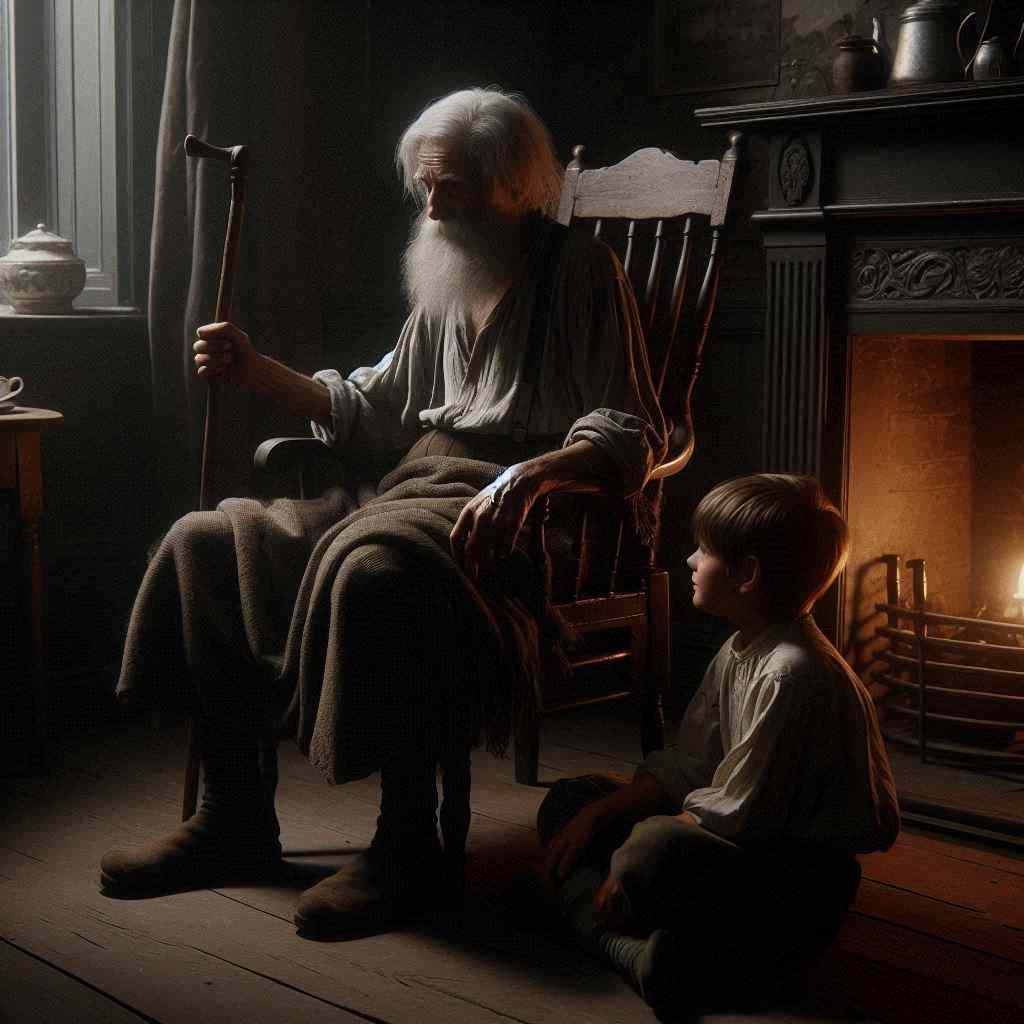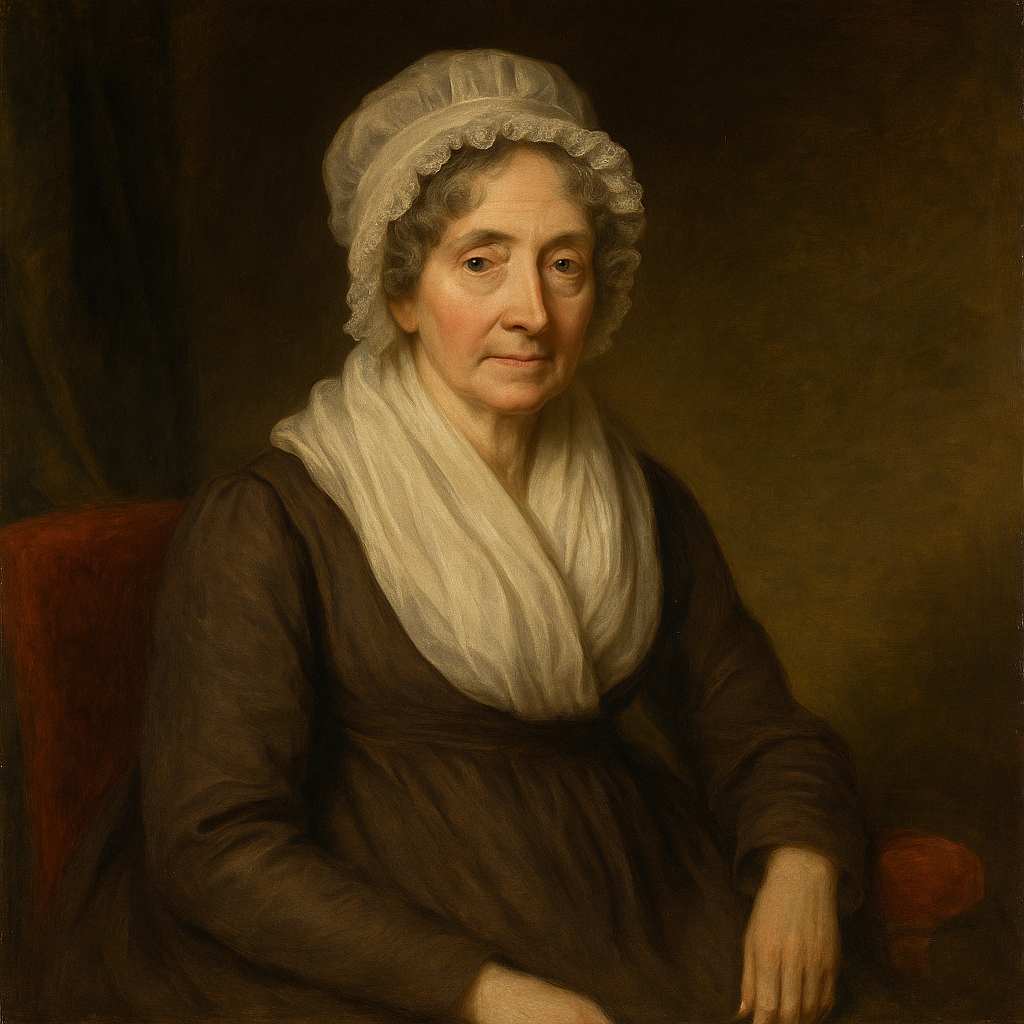A Child To His Sick Grandfather
Joanna Baillie
1762 to 1851

Want to track your favorites? Reopen or create a unique username. No personal details are required!
Grand-dad , they say you're old and frail,
Your stiffened legs begin to fail:
Your staff, no more my pony now,
Supports your body bending low,
While back to wall you lean so sad,
I'm vex'd to see you, Dad.
You used to smile and stroke my head,
And tell me how good children did;
But now, I wot not how it be,
You take me seldom on your knee,
Yet ne'ertheless I am right glad,
To sit beside you, Dad.
How lank and thin your beard hangs down!
Scant are the white hairs on your crown:
How wan and hollow are your cheeks,
Your brow is crossed with many streaks;
But yet although his strength be fled,
I love my own old Dad.
The housewives round their potions brew,
And gossips come to ask for you;
And for your weal each neighbour cares;
And good men kneel and say their prayers,
And every body looks so sad,
When you are ailing, Dad.
You will not die and leave us then?
Rouse up and be our Dad again.
When you are quiet and laid in bed,
We'll doff our shoes and softly tread;
And when you wake we'll still be near,
To fill old Dad his cheer.
When through the house you change your stand,
I'll lead you kindly by the hand:
When dinner's set I'll with you bide,
And aye be serving by your side;
And when the weary fire burns blue,
I'll sit and talk with you.
I have a tale both long and good,
About a partlet and her brood,
And greedy cunning fox that stole
By dead of midnight through a hole,
Which slyly to the hen-roost led,--
You love a story, Dad?
And then I have a wondrous tale
Of men all clad in coats of mail,
With glittering swords,--you nod,--I think
Your heavy eyes begin to wink;--
Down on your bosom sinks your head:--
You do not hear me, Dad.
Joanna Baillie's A Child To His Sick Grandfather
Introduction
Joanna Baillie's poem "A Child To His Sick Grandfather" is a poignant exploration of the relationship between youth and age, innocence and experience, and the cyclical nature of life and care. This 19th-century work, with its simple language and touching sentiment, belies a complex tapestry of themes that resonate deeply with the human experience. Through the eyes of a child addressing his ailing grandfather, Baillie crafts a narrative that is both deeply personal and universally relatable, inviting readers to contemplate the passage of time, the bonds of family, and the inevitable confrontation with mortality.
Structure and Form
The poem consists of eight stanzas, each containing six lines with an AABCCB rhyme scheme. This structure lends itself to a lyrical quality that mimics the cadence of speech, particularly that of a child's earnest and sometimes rambling address. The regularity of the form contrasts with the content, which deals with the irregularities and uncertainties of aging and illness.
Baillie's choice of meter is particularly noteworthy. The poem predominantly uses iambic tetrameter, a rhythm that closely resembles natural speech patterns in English. This metrical choice enhances the sense of a genuine, heartfelt conversation between the child and his grandfather. However, Baillie occasionally varies this pattern, particularly in the shorter fourth and sixth lines of each stanza, which often employ trochaic or anapestic feet. This variation serves to emphasize key emotional points and mirrors the uneven, halting nature of the grandfather's declining health.
Narrative Perspective
The use of a child narrator is a masterstroke by Baillie, allowing her to approach the weighty themes of aging and death with a unique blend of innocence and insight. The child's perspective provides a lens through which the reader can view the grandfather's decline without the full weight of adult understanding, yet with an intuitive grasp of the gravity of the situation.
This narrative choice also enables Baillie to employ dramatic irony effectively. The reader, understanding more than the child about the implications of the grandfather's condition, experiences a layered emotional response to the poem. We are simultaneously touched by the child's devotion and saddened by our adult knowledge of the likely outcome, creating a bittersweet resonance that persists throughout the work.
Themes and Symbolism
The Cycle of Care
One of the central themes of the poem is the cyclical nature of care within families. The child, recalling how the grandfather once cared for him ("You used to smile and stroke my head, / And tell me how good children did"), now finds himself in the position of caregiver. This role reversal is symbolized by the transformation of the grandfather's staff from a plaything ("Your staff, no more my pony now") to a necessary support for the old man's "body bending low."
This theme speaks to the broader human experience of aging and familial responsibility. Baillie suggests that there is a natural order to life, where the cared-for become the caregivers, and vice versa. This cycle is presented not as a burden, but as a natural and even beautiful part of the human experience.
The Confrontation with Mortality
Throughout the poem, there is an undercurrent of the child's growing awareness of mortality. The detailed descriptions of the grandfather's physical decline ("How lank and thin your beard hangs down! / Scant are the white hairs on your crown") serve not only to paint a vivid picture but also to chart the child's dawning realization of the fragility of life.
The child's plea, "You will not die and leave us then?" is particularly poignant, representing a pivotal moment of understanding. It's a question that hangs in the air, unanswered and perhaps unanswerable, embodying the human struggle to come to terms with the inevitability of death.
The Power of Storytelling
Baillie introduces the motif of storytelling as a means of connection and comfort. The child offers to tell tales to his grandfather, both "long and good" stories about everyday occurrences and fantastical narratives of "men all clad in coats of mail." This emphasis on storytelling serves multiple purposes within the poem.
Firstly, it represents the child's attempt to reciprocate the care he once received, offering entertainment and distraction in place of the stories and lessons his grandfather once provided. Secondly, it symbolizes the passing down of cultural and familial knowledge from one generation to the next, a process that continues even as the older generation declines. Lastly, it suggests the power of narrative to provide comfort and meaning in the face of difficult realities.
Language and Imagery
Baillie's use of language is deceptively simple, befitting the child narrator. However, this simplicity is carefully crafted to convey deep emotional truths. The poem is rich with sensory imagery that brings the scene vividly to life. The visual descriptions of the grandfather's physical state are particularly striking, from his "wan and hollow" cheeks to his brow "crossed with many streaks."
The poet also employs auditory imagery to great effect, particularly in the later stanzas where the child promises to "doff our shoes and softly tread." This creates a sense of the hushed atmosphere surrounding illness and impending loss, while also emphasizing the child's desire to provide comfort and care.
Baillie's diction choices further reinforce the poem's themes. Words like "frail," "stiffened," and "bending" in the opening stanza immediately establish the grandfather's physical decline, while terms of endearment like "Grand-dad" and "Dad" peppered throughout the poem underscore the deep affection at the heart of the relationship.
Conclusion
"A Child To His Sick Grandfather" is a masterful exploration of the human experience of aging, family bonds, and the confrontation with mortality. Through her use of a child narrator, Joanna Baillie creates a work that is at once deeply personal and universally resonant. The poem's structure, themes, and language work in concert to produce a powerful emotional effect, inviting readers to reflect on their own experiences of family, care, and the passage of time.
Baillie's work stands as a testament to the power of poetry to illuminate the most fundamental aspects of the human condition. By focusing on a simple interaction between a child and his ailing grandfather, she touches upon profound truths about love, duty, the cycle of life, and the ways in which we confront the inevitability of loss. In doing so, she creates a work that continues to speak to readers across generations, reminding us of the enduring power of familial love and the bittersweet beauty inherent in the human journey from cradle to grave.
This text was generated by AI and is for reference only. Learn more
Want to join the discussion? Reopen or create a unique username to comment. No personal details required!



Comments
No comments yet. Be the first to comment!